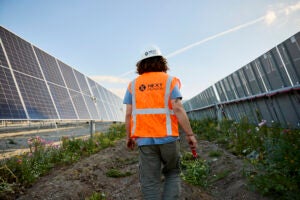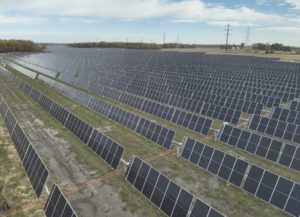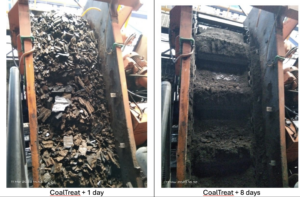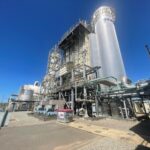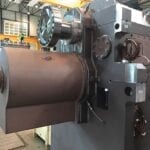Large distances are something you get used to if you live in Australia. Perth, on the west coast, is about 2,500 miles away from Brisbane on the east coast. Even within the state of Western Australia (WA), the distances are immense. There are two separate non-integrated grids that only serve part of the state.
The North West Interconnected System (NWIS) is about 1,000 miles away from Perth. It covers the area around the towns of Karratha and Port Hedland. It reaches inland and eastward to service mining operations. But the biggest network is to the south with Perth at its core. The South West Interconnected System (SWIS) has Western Power as the owner and operator of the transmission and distribution infrastructure, and Synergy as a major generator and retailer of electricity. Both are owned by the WA government. Within SWIS (Figure 1), Kalbarri is almost 400 miles north of Perth, Bremer Bay is about 300 miles to the southeast of Perth, and the gold mining region around West Kalgoorlie is about 400 miles east.
 |
|
1. The South West Interconnected System (SWIS) in Western Australia has almost 8,000 kilometers (5,000 miles) of transmission lines. Courtesy: Western Power |
Due to the surge of renewables, SWIS now boasts a duck curve comparable to that of California. About a third of the homes on the grid have rooftop photovoltaic (PV) systems installed. Together, they can generate twice as much electricity as the largest power station on the system at the peak of a hot summer’s day. During the evening peak, power is needed fast from sources such as the many coal, natural gas, waste-to-energy, wind, and battery energy storage systems (BESS) around the region.
The projections for the duck curve are that it is going to continue to deepen. The state’s PoweringWA decarbonization initiative has set ambitious targets to reduce carbon emissions by 80% by 2030 (compared to 2020 levels) and achieve net zero by 2050. Recent additions include the Merredin Solar Farm, 260 kilometers (km) east of Perth. Its 360,000 solar panels can generate 281 GWh of electricity annually. Plenty more BESS is being added to the 100 MW/200 MWh in the Perth area that Synergy has already deployed. Altogether, about 4,000 km of new transmission lines and 50 GW of new renewable electricity and storage infrastructure are expected to be added to SWIS over the next two decades.
To address the current peak period challenge, Synergy and the other utilities operating in the area are attempting to entice people to switch consumption to the middle of the day to use up available solar energy. Virtual power plants (VPPs) have been created that adjust and respond to the needs of the electricity system more rapidly by better incorporating distributed energy resources (DERs) into the power system. Meanwhile, emergency solar management (ESM), a capability introduced by the WA government, remotely manages household solar, temporarily cutting it off when there is an excess to prevent potential outages.
The initial idea in much of Australia has been to retire coal and natural gas plants, and transition rapidly to renewables. These plans have been amended due to phenomena such as the duck curve of SWIS and grid instability problems. As rotating assets are taken off the grid, the inherent inertia provided by steam turbines and gas turbines is badly missed. Renewables can’t replace them so the grid suffers from frequency spikes and troughs, lack of reactive power, and other woes that could result in blackouts in extreme cases.
The PoweringWA initiative, therefore, now includes investment in pipeline infrastructure, gas generation to provide firming to the energy system, and the addition of equipment to stabilize the grid. Existing gas plants, for example, have been granted a 10-year exemption from new emission thresholds.
Take the case of the Pinjar Power Station (Figure 2) near Perth, which consists of six GE Vernova Frame 6s and three Frame 9s. Operated by Synergy, its capacity of 576 MW can be online and available to the grid within 15 minutes. This is just the kind of firming capacity SWIS needs to respond to sudden power shortfalls, particularly at the end of the day when people return home from work.
 |
|
2. The Pinjar power station near Perth, Australia, is undergoing upgrades to strengthen the grid. Courtesy: Synergy |
Plants like this require a hefty capital investment and incur significant operating costs. If they only run for an hour or two each day, it may not be enough to justify their continued operation. Fortunately, the state now compensates facilities for the provision of ancillary services.
With more and more wind and solar flooding onto the grids around the country, the Australian Energy Market Operator (AEMO) conducted a detailed study of the consequences. It realized that closing coal plants wholesale and gradually eliminating the remaining natural gas plants was causing issues in various regions. Synchronous alternating current generators such as coal plants and natural gas plants (simple cycle and combined cycle) contained inherent characteristics critical for secure power system operation and grid support. They provide a power system with essential services such as:
- Inertia. Large masses of rotating machinery that provide a degree of resistance to change as a consequence of disturbances.
- System Strength. Synchronous alternating current machines produce large short-circuit fault currents, the necessary response to maintain constant power output during a fault-related drop in voltage.
- Voltage Control. Synchronous alternating current machines absorb and generate reactive power needed to control voltage levels.
- Frequency Control. Ability to automatically vary rotational speed in response to variations in demand.
- Dispatchability. Able to be dispatched and output raised or lowered as needed within ramp limits of the units.
The study concluded that by continuing down the path of fossil plant elimination, there would be an increased likelihood of cascading failures on the system, widespread load shedding, and perhaps even blackouts if no action was taken now to implement the technologies and regulatory reforms to support renewable generation technologies. At SWIS, it was found that failure to address the problem would make the grid increasingly unstable, requiring intervention to constrain non-synchronous generation. Thus, a variety of programs and incentives were devised to create a more attractive ancillary services framework. The report called for identification of optimal locations for the deployment of synchronous condensers or other applicable technologies to manage system strength and inertia to required levels. The result: AEMO’s Wholesale Electricity Market (WEM) rules that compensate power producers for services such as load following, load rejection, spinning reserve, and synchronous condensing.
An AEMO report stated: “Technical standards, and regulatory and market constructs, require carefully designed but urgent change, to implement or incentivise new technologies in the SWIS such as synchronous compensation, energy storage, and increased inverter capabilities. AEMO recommends the urgent incorporation of new technologies in the grid such as energy storage systems and synchronous condensers, together with the adoption of updated inverter standards combined with market and regulatory changes.”
At the Pinjar Power Station, several of the units are now installed with synchronous self-shifting clutches from SSS Gears Ltd. of Sunbury, UK. These units provide system stability and grid support. When the turbine is moving faster than the generator, the clutch automatically is engaged, and the turbine drives the generator. Once the generator is synchronized to the grid, the turbine slows down and the clutch automatically disconnects from the generator, turning it into a synchronous condenser. These SSS clutches (Figure 3) are incorporated into the load gears made by Flender-Graffenstaden of Strasbourg, France.
 |
|
3. Several generators at the Pinjar Power Station were retrofitted with size 194T synchronous self-shifting (SSS) clutches that were incorporated into the Flender-Graffenstaden load gears to provide reactive power and system support. The company has recently received orders for 16 more turbomachinery gear boxes, all with the SSS clutch installed. Courtesy: Flender-Graffenstaden |
“In recent years, there has been a focus on the need for synchronous compensating functions worldwide,” said Jean-Bernard Gross, technical and sales area manager for Australia at gearbox manufacturer Flender-Graffenstaden. “This is in line with the worldwide push for renewables integration and the need for increased system inertia and system strength.”
This synchronous condensing upgrade provides benefits to the grid. Reactive power provided by a synchronous condenser offers voltage support and raises transmission efficiency by boosting the amount of power that can be transmitted over a line.
Due to the large distances involved in WA, plenty of reactive power support is needed. With coal plant retirements moving forward, the need for system stability is only going to increase. Synergy’s last two coal power stations are scheduled for closure over the next couple of years, representing close to 1.2 GW of generation.
To ensure the Pinjar plant could fulfill its requirements for the provision of ancillary services, Synergy placed an order for a critical spare load gear and SSS clutch to ensure that unexpected faults, failures, or routine maintenance do not diminish the ability of the system to supply real and reactive power.
“There has been an increasing requirement from the grid operator to validate the availability of the synchronizing condenser function and hence the requirement for the purchase of the critical spare,” said Gross. “We received an order for a replacement gearbox at Pinjar with an SSS clutch to act as a critical spare gear box for the fleet in Pinjar with synchronizing condenser functions.”
In conclusion, Western Australia continues to go full throttle with its renewable ambitions. But it is supporting those ambitions with essential transmission and grid support actions to ensure the region’s population can continue to depend on a steady supply of electricity.
—Drew Robb (drewrobb@sbcglobal.net) has been a full-time freelance writer for more than 25 years specializing in engineering and technology.



